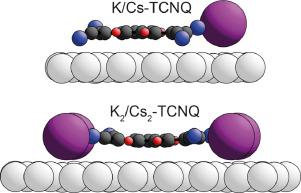当前位置:
X-MOL 学术
›
Surf. Sci.
›
论文详情
Our official English website, www.x-mol.net, welcomes your feedback! (Note: you will need to create a separate account there.)
The structure of 2D charge transfer salts formed by TCNQ/alkali metal coadsorption on Ag(111)
Surface Science ( IF 1.9 ) Pub Date : 2020-11-01 , DOI: 10.1016/j.susc.2020.121687 P.J. Blowey , L.A. Rochford , D.A. Duncan , P.T.P. Ryan , D.A. Warr , T.-L. Lee , G. Costantini , D.P. Woodruff
Surface Science ( IF 1.9 ) Pub Date : 2020-11-01 , DOI: 10.1016/j.susc.2020.121687 P.J. Blowey , L.A. Rochford , D.A. Duncan , P.T.P. Ryan , D.A. Warr , T.-L. Lee , G. Costantini , D.P. Woodruff

|
Abstract The structure of coadsorption phases formed on Ag(111) by TCNQ (7,7,8,8-tetracyanoquinodimethane) with Cs are compared with previously reported coadsorption phases formed with K, following investigation by scanning tunnelling microscopy (STM), low energy electron diffraction, soft X-ray photoelectrons spectroscopy and normal incidence X-ray standing waves (NIXSW). For each alkali we identify two ordered phases, one with an alkali: TCNQ stoichiometry of 1:1 and the other 2:1. STM images show the molecular organisation is the same for Cs and K, although only the K2TCNQ phase is commensurate with the substrate. A previously-published detailed structure determination of the K2TCNQ phase, complemented by density function theory calculations that identify bonding strengths, showed that the binding within the layer is much stronger than that of the layer to the substrate. Insensitivity to commensuration is thus to be expected. The situation for KTCNQ and CsTCNQ is less clear; these ordered incommensurate overlayers clearly have strong intralayer bonding, but the relative strength of the average overlayer-substrate bonding is unknown. NIXSW data show that the alkalis in these phases occupy adsorption sites far more distant from the substrate than the TCNQ molecules when compared to the near coplanar alkali-TCNQ geometry of K2TCNQ and Cs2TCNQ. Ultraviolet photoelectron spectra show increasing bonding shifts of TCNQ orbital states with alkali coverage.
中文翻译:

TCNQ/碱金属共吸附在Ag(111)上形成的二维电荷转移盐的结构
摘要 将 TCNQ(7,7,8,8-四氰基醌二甲烷)与 Cs 在 Ag(111) 上形成的共吸附相的结构与先前报道的 K 形成的共吸附相进行了比较,通过扫描隧道显微镜 (STM)、低能量电子衍射、软 X 射线光电子能谱和法向入射 X 射线驻波 (NIXSW)。对于每种碱,我们确定两个有序相,一个带有碱:TCNQ 化学计量比为 1:1,另一个为 2:1。STM 图像显示 Cs 和 K 的分子组织是相同的,尽管只有 K2TCNQ 相与底物相称。先前发表的 K2TCNQ 相的详细结构测定,辅以密度函数理论计算,以确定键合强度,表明层内的结合比层与基底的结合强得多。因此可以预料到对相称不敏感。KTCNQ 和 CsTCNQ 的情况不太清楚;这些有序的不相称覆盖层显然具有很强的层内粘合,但平均覆盖层 - 基材粘合的相对强度是未知的。NIXSW 数据表明,与 K2TCNQ 和 Cs2TCNQ 的近共面碱-TCNQ 几何形状相比,这些相中的碱占据比 TCNQ 分子更远的吸附位点。紫外光电子光谱显示,随着碱覆盖,TCNQ 轨道状态的键合位移增加。这些有序的不相称覆盖层显然具有很强的层内粘合,但平均覆盖层 - 基材粘合的相对强度是未知的。NIXSW 数据表明,与 K2TCNQ 和 Cs2TCNQ 的近共面碱-TCNQ 几何形状相比,这些相中的碱占据比 TCNQ 分子更远的吸附位点。紫外光电子光谱显示,随着碱覆盖,TCNQ 轨道态的键合位移增加。这些有序的不相称覆盖层显然具有很强的层内粘合,但平均覆盖层 - 基材粘合的相对强度是未知的。NIXSW 数据表明,与 K2TCNQ 和 Cs2TCNQ 的近共面碱-TCNQ 几何形状相比,这些相中的碱占据比 TCNQ 分子更远的吸附位点。紫外光电子光谱显示,随着碱覆盖,TCNQ 轨道状态的键合位移增加。
更新日期:2020-11-01
中文翻译:

TCNQ/碱金属共吸附在Ag(111)上形成的二维电荷转移盐的结构
摘要 将 TCNQ(7,7,8,8-四氰基醌二甲烷)与 Cs 在 Ag(111) 上形成的共吸附相的结构与先前报道的 K 形成的共吸附相进行了比较,通过扫描隧道显微镜 (STM)、低能量电子衍射、软 X 射线光电子能谱和法向入射 X 射线驻波 (NIXSW)。对于每种碱,我们确定两个有序相,一个带有碱:TCNQ 化学计量比为 1:1,另一个为 2:1。STM 图像显示 Cs 和 K 的分子组织是相同的,尽管只有 K2TCNQ 相与底物相称。先前发表的 K2TCNQ 相的详细结构测定,辅以密度函数理论计算,以确定键合强度,表明层内的结合比层与基底的结合强得多。因此可以预料到对相称不敏感。KTCNQ 和 CsTCNQ 的情况不太清楚;这些有序的不相称覆盖层显然具有很强的层内粘合,但平均覆盖层 - 基材粘合的相对强度是未知的。NIXSW 数据表明,与 K2TCNQ 和 Cs2TCNQ 的近共面碱-TCNQ 几何形状相比,这些相中的碱占据比 TCNQ 分子更远的吸附位点。紫外光电子光谱显示,随着碱覆盖,TCNQ 轨道状态的键合位移增加。这些有序的不相称覆盖层显然具有很强的层内粘合,但平均覆盖层 - 基材粘合的相对强度是未知的。NIXSW 数据表明,与 K2TCNQ 和 Cs2TCNQ 的近共面碱-TCNQ 几何形状相比,这些相中的碱占据比 TCNQ 分子更远的吸附位点。紫外光电子光谱显示,随着碱覆盖,TCNQ 轨道态的键合位移增加。这些有序的不相称覆盖层显然具有很强的层内粘合,但平均覆盖层 - 基材粘合的相对强度是未知的。NIXSW 数据表明,与 K2TCNQ 和 Cs2TCNQ 的近共面碱-TCNQ 几何形状相比,这些相中的碱占据比 TCNQ 分子更远的吸附位点。紫外光电子光谱显示,随着碱覆盖,TCNQ 轨道状态的键合位移增加。


























 京公网安备 11010802027423号
京公网安备 11010802027423号